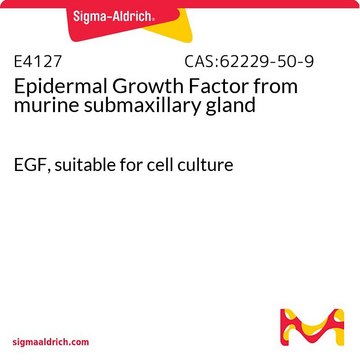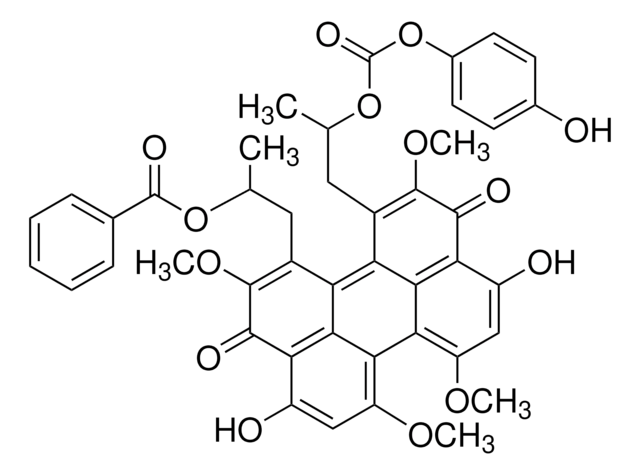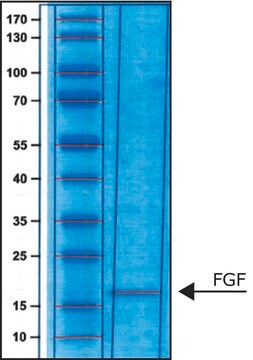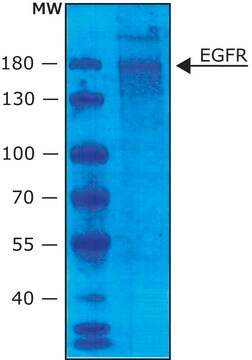E5036
Epidermal Growth Factor Protein, human
>97% (SDS-PAGE), recombinant, expressed in E. coli, lyophilized powder, suitable for cell culture
Sinonimo/i:
EGF
About This Item
Prodotti consigliati
product name
Fattore di crescita epidermico, EGF, recombinant, expressed in Escherichia coli, >97% (SDS-PAGE)
Origine biologica
human
Livello qualitativo
Ricombinante
expressed in E. coli
Saggio
>97% (SDS-PAGE)
Forma fisica
lyophilized powder
Potenza
0.08-0.8 ng/mL EC50
PM
~6 kDa
Confezionamento
pkg of 200 and 500 μg
Condizioni di stoccaggio
avoid repeated freeze/thaw cycles
Impurezze
≤1 EU/μg Endotoxin
Colore
white
Solubilità
water: soluble 0.190-0.210, clear, colorless
N° accesso UniProt
Temperatura di conservazione
−20°C
Informazioni sul gene
human ... EGF(1950)
Cerchi prodotti simili? Visita Guida al confronto tra prodotti
Descrizione generale
Applicazioni
- as a supplement in in LHC-8 medium to culture liver cell lines
- in the fetal bovine serum (FBS)-Dulbecco′s modified essential medium (DMEM) /F12 medium for primary culture of human glioma cells
- as an additive in the conditional medium of normal fibroblasts (NFs) to study its effect on the migration and invasion of endometrial cancer (EC) cells
- as a component in tumorsphere medium
Azioni biochim/fisiol
Citazione
2. Gregory, H., Isolation and structure of urogastrone and its relationship to epidermal growth factor. Nature, 257, 325-327 (1975).
3. George-Nascimento, C. et al., Characterization of recombinant human epidermal growth factor produced in yeast. Biochemistry, 27, 797-802 (1988).
4. Todaro, G.J. et al., Transforming growth factors produced by certain human tumor cells: polypeptides that interact with epidermal growth factor receptors. Proc. Natl. Acad. Sci. USA, 77, 5258-5262 (1980).
5. Blomquist, M.C. et al., Vaccinia virus 19-kilodalton protein: relationship to several mammalian proteins, including two growth factors. Proc. Natl. Acad. Sci. USA, 81, 7363-7367 (1984).
6. Eppstein, D.A. et al., Epidermal growth factor receptor occupancy inhibits vaccinia virus infection. Nature, 318, 663-665 (1985).
Codice della classe di stoccaggio
13 - Non Combustible Solids
Classe di pericolosità dell'acqua (WGK)
WGK 2
Punto d’infiammabilità (°F)
Not applicable
Punto d’infiammabilità (°C)
Not applicable
Certificati d'analisi (COA)
Cerca il Certificati d'analisi (COA) digitando il numero di lotto/batch corrispondente. I numeri di lotto o di batch sono stampati sull'etichetta dei prodotti dopo la parola ‘Lotto’ o ‘Batch’.
Possiedi già questo prodotto?
I documenti relativi ai prodotti acquistati recentemente sono disponibili nell’Archivio dei documenti.
I clienti hanno visto anche
Il team dei nostri ricercatori vanta grande esperienza in tutte le aree della ricerca quali Life Science, scienza dei materiali, sintesi chimica, cromatografia, discipline analitiche, ecc..
Contatta l'Assistenza Tecnica.












